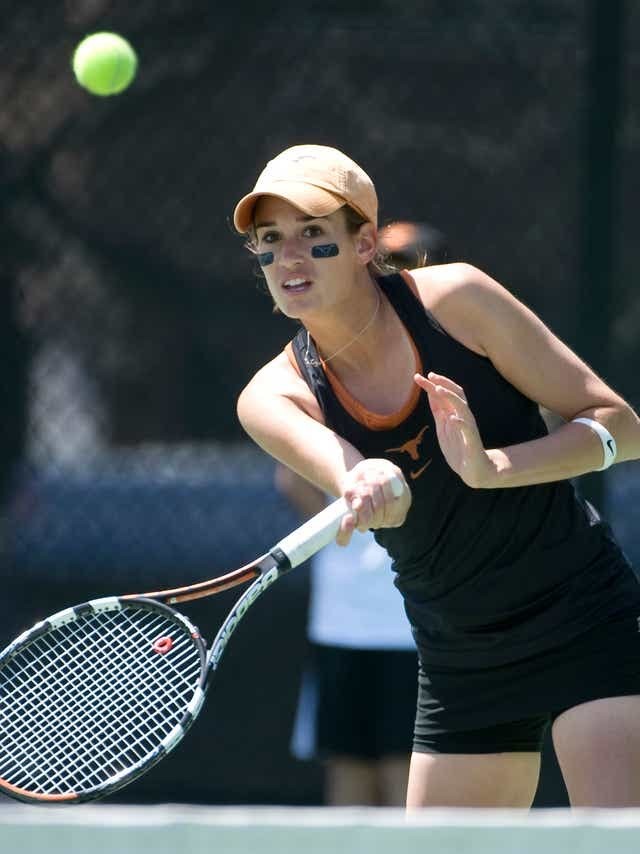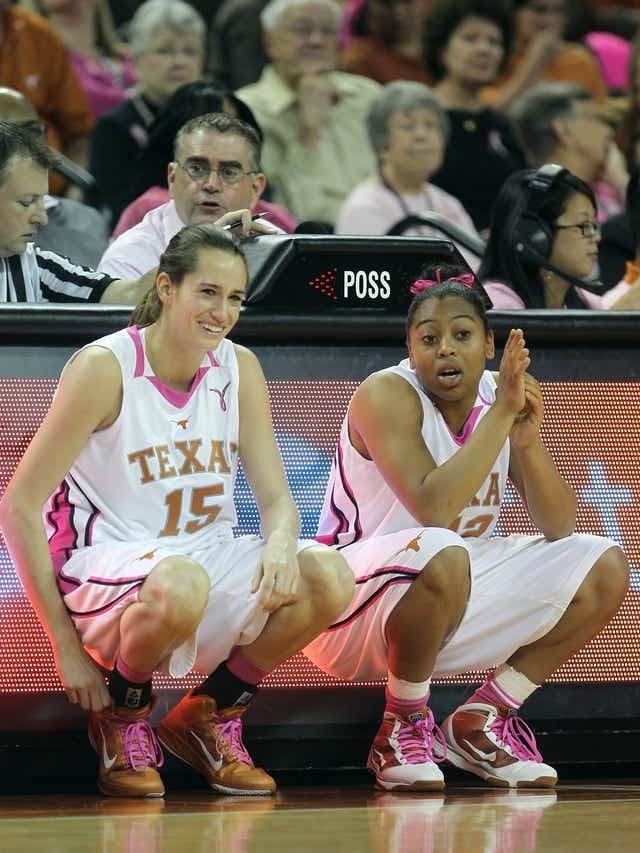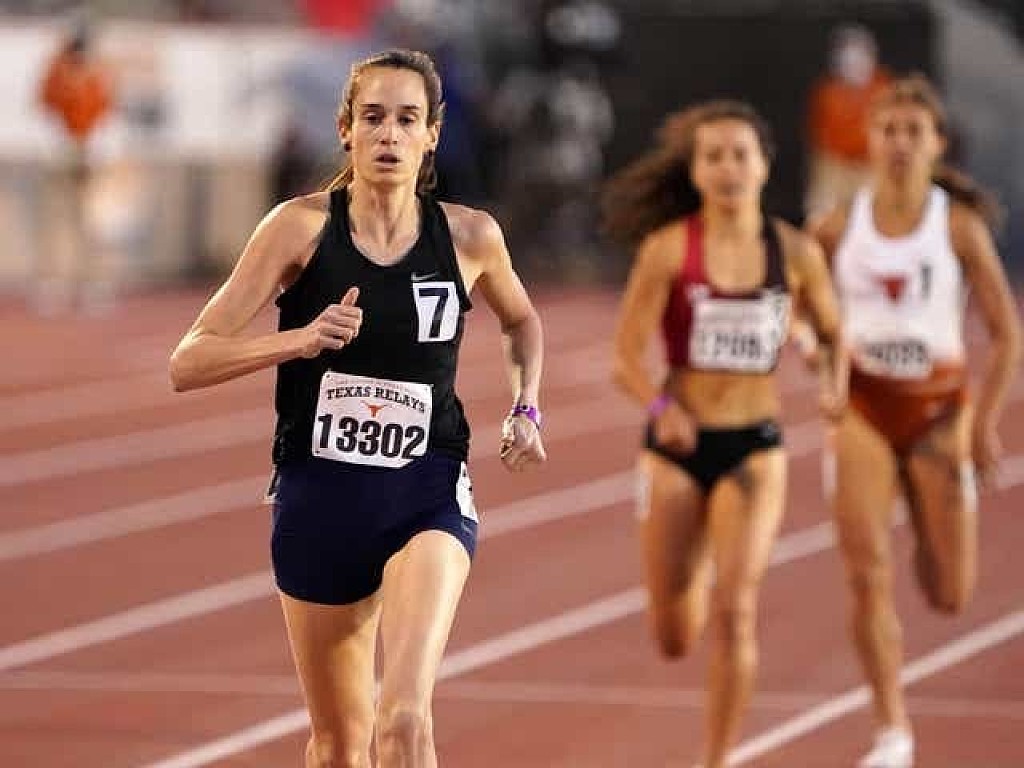Running News Daily
Running News Daily is edited by Bob Anderson. Send your news items to bob@mybestruns.com Advertising opportunities available. Train the Kenyan Way at KATA Kenya and Portugal owned and operated by Bob Anderson. Be sure to catch our movie A Long Run the movie KATA Running Camps and KATA Potato Farms - 31 now open in Kenya! https://kata.ke/
Index to Daily Posts · Sign Up For Updates · Run The World Feed
Sarah Lancaster was born to run but she also excelled in tennis and basketball too
If you’ve spent early mornings on the trails near downtown Austin, Texas you’ve probably crossed paths with Sarah Lancaster — 5 feet, 8 inches of mostly limbs and ponytail, casually eating up miles faster than you could drive on the Hike and Bike Trail, or sprinting so fast around the Austin High track off Lady Bird Lake that her male training partners have to tag each other in for pacing duty.
Lancaster is not just the fastest runner in Austin. She's one of the fastest women in the entire country, and she's competing at the U.S. Olympic Trials in Eugene, Ore., on Friday in both the 1,500- and 5,000-meter runs.
Her personal bests of 4 minutes, 5.55 seconds and 15:13.56 are only a few seconds off the Olympic standards of 4:04.20 and 15:10, meaning she can make this summer's Tokyo Olympics team if she can shave a few seconds off her best times and place in the top three.
Texas legend Trey Hardee, a 2012 Olympic silver medalist in the decathlon, recently declared Lancaster the best athlete in Longhorns history on Twitter, although that actually has as much to do with her pedigree as a dual-sport athlete at UT in tennis and basketball as it does her running resume.
At 33 years old, Lancaster is nearly 15 years behind most of her competitors in terms of specific training for distance running. She works full-time as an attorney in Austin, but nearly everyone who has run with her or coached her agrees: the former tennis ace possesses an unbeatable work ethic and killer instinct that makes her a natural on the track, no matter how late she found the sport.

Tennis beginnings
Lancaster grew up in San Antonio playing every sport offered, but quickly found herself drawn to tennis and basketball. She started taking tennis lessons when she was six years old and was competing in statewide tournaments by the time she was 11.
Lancaster's mother, Kelly, says Sarah was competitive "in everything. It wasn't necessarily sports," and that she inadvertently stoked the fire a few times when Sarah drew a tough opponent during a travel tournament.
“I would say, ‘Oh gosh, you play so-and-so today, I just hope you get a point,’” Kelly Lancaster said. “Because maybe it was one of the top girls in Texas. She’s commented that I’d pack up our bags to check out of the hotel because I knew she was playing somebody (who was a top seed). And you can always go check back in, but if you don’t check out by 10 or 11, then you have to pay for a whole ‘nother day.
“She said, ‘I’d see mom packing up the bags and think, ‘Obviously, she doesn’t think I’m gonna win today, so I’m gonna show her!' I really didn’t do it for that reason. I was thinking, ‘We’re done, I’m tired, we’re going home.’ Little things like that, I guess, motivated her a little bit to prove me wrong.”
Lancaster played tennis, basketball and ran track during her freshman year at Alamo Heights High School before deciding to enroll in a tennis academy that her coach established more than 200 miles away in Conroe. The academy is no longer in existence, but at the time was affiliated with John Roddick, the older brother of tennis star Andy Roddick.
“I was 15 at the time and, looking back at it, I can’t believe my parents let me do that,” Lancaster said.
A typical day at the tennis academy included two hours of practice in the morning, home school sessions for five to six hours, and another afternoon practice session that could last anywhere from two to three hours. There were about five other female boarders, more young men, and a number of local kids from the area who drove in for practice every day.
“We had a good time,” Lancaster said. “It was definitely not your normal high school experience. ... We were at tournaments a lot, we would go to the movies or just normal things like that ... (but) you’re there to play tennis and you’re there to get good, you’re not there to be partying and having fun.”
Lancaster thrived in the environment, improving her national and state rankings to become one of the best players in Texas.

“For me, it was — I want to go and I want to get as good as I can and see what I can do,” she said of her motivation to attend the tennis academy. “Maybe a little part of me thought I was going to play professionally one day, but I think the focus for me was more on college ... making sure I was going to be recruited.”
Lancaster committed to Texas — "hands down my first choice" — but then suffered a stress fracture in her back and had to take a few months off from tennis. She moved back home and re-enrolled at Alamo Heights, where her old friends convinced her to play basketball again.
It was an easy sell. After all, she was already the best player when she was only a freshman.
"I talked to the UT tennis coach," Lancaster said. "'Hey, you know, I'd kind of like to play basketball. I think it would be fun for me and it might be good for me, coming back from this injury, to do a different sport.'" And she was agreeable to it as long as I taped my ankles for every practice or game."
The move was eerily prescient for her career at Texas. Also prescient — she ran a few track races (she said her best time was a 58-second 400 meters as a freshman).
Texas fight
Given her experience living away from home at the tennis academy, Lancaster’s transition to college and NCAA athletics was pretty seamless. The Texas women’s tennis team, which recently captured its third national championship, was solidly ranked within the top 10 to 20 programs in the nation during her years there, and as a senior in 2010, she helped the Longhorns to the Sweet 16 round of the NCAA Tournament while totaling a 25-8 singles record, including an 11-0 mark in the Big 12.
“She is one of the best competitors I ever coached,” former UT women’s tennis coach Patty Fendick-McCain said in a text message. “She was the most solid player I ever coached at her position and when the chips were down, I always knew she would come through. She didn’t care what line she played, but that she would get a ‘W’ and contribute to the team.”
Of her own heroics on the court, Lancaster says simply that her personal highlight of her college tennis career was “probably the fact that we beat A&M every time we played them.”
Bored over the summer after her senior year and with one extra semester of school to complete, Lancaster and one of her tennis teammates filmed a video of her doing a trick layup shot. They sent it to their coach, who forwarded the video to the women’s basketball coach at the time, Gail Goestenkors.
To Lancaster’s surprise, Goestenkors told her to go play some pick-up games that summer with the team.
"I went and played with them over the summer, and it was really just pick-up games, coaches couldn't come," Lancaster said. "I didn't really feel like I was completely in over my head, you know — I wasn't like, 'Oh, I'm better than any of these people that have been playing their whole lives and have been recruited to play at the University of Texas,' (but) I felt like I could hold my own."
Sight unseen, based on positive feedback from the players on the team, Lancaster was invited to officially join the roster in the fall.
"None of the coaches had ever seen me play and they basically told me that they would let me play on the team, which was a little bit terrifying,” she said. “The first practice, I was like, please do not miss a layup, please do not miss a layup.
"I think part of it was, the team was really young, there were six or seven freshmen. There was really only one other senior at the time on the team and I think they were just kind of like, 'Sarah knows how to be a student-athlete, she can help these freshmen.' And I guess they confirmed with some other people that I wasn't a terrible basketball player."
Lancaster stepped into the leadership role naturally, had fun at practice and was fine with getting less minutes as the season went on. Her personal highlight from her basketball career didn’t even take place in the Big 12.
"My only basketball highlight is in seventh grade, when I scored 46 points in a game," she said with a straight face.
'That’s just not something you see every day'
Paras Shah remembers the first time Lancaster showed up to a casual evening workout with RAW Running a few years ago. She made it up Wilke Road — a notoriously brutal 300-meter, 10.8% grade hill in the Barton Hills neighborhood — for all eight repeats, just a few strides behind Shah and the other former NCAA Division I male runners in the group.
"I asked her where she ran in college and she said she didn’t," said Shah, who ran at LSU. "(I thought) that’s obviously not possible. I just didn’t believe her.”
Lancaster was always naturally fast.
In mile time trials throughout her athletic career, she’d routinely clock in just under 5:30.
"Every running drill we did, Sarah was fastest and had the best endurance," Fendick-McCain said. "Her attitude was to leave blood on the court if necessary. She had better endurance than any other player I ever coached or that she played against. If it was a test of wills and endurance, she would always find a way to win."
When Lancaster started law school, she played in various recreational leagues and just had fun ("law school was the most free time I've ever had in my life," she said) while casually completing her first half-marathon. But a few years into the workforce, she happened to meet UT club running coach Kyle Higdon, a UT graduate student, and she asked him to train her to break five minutes in the mile.
"I just felt like that would be a cool thing to say I could do," she said. "And I had actually talked to multiple guys who told me that they tried to do it and couldn't do it. So I was, you know, even more motivated to try."
With light mileage (20-25 miles per week) and a few basic workouts under her belt, she clocked 4:46 in her first 1,500 meter race — the equivalent of a 5:07 mile. By the end of the spring, she had improved to about 4:30 for the 1,500, an incredible time for a brand new runner, albeit one who was 28.
As she watched the Rio Olympics that summer, she wondered: Could she qualify for the 2020 Olympic Trials?
“I had no concept of what a good time was,” she said.
The idea of the Trials wasn’t quite a solidified goal at that point — just a little bug in her head that popped up every now and then. With Higdon finishing his studies and moving on with his career, Lancaster evaluated her group running options, which, in Austin, are mostly marathon training groups that meet in the wee hours of the morning, or more casual after-work clubs.
She chose the latter, and started showing up to RAW. That’s where she met Shah, who helps organize the annual Schrader 1600 every May for high school runners and members of the community.
At the 2018 event, with about two years of casual training under her belt, Lancaster ran 4:37.55 for 1,600 meters. The girl who kicked the boys’ butts at RAW workouts every Tuesday was legit.
Mike Kurvath remembers the race very vividly. Then 28, the Rochester Institute of Technology (RIT) track alum ran 4:17 in his section. At the time, he was thinking of moving on from running competitively.
"I remember that very specifically, because in the final 200 meters, she elbowed her way through a couple of high schoolers and it was a really strong move," Kurvath said. "That’s just not something you see every day.
"I was thinking that I was going to be done with running. After I saw that race ... it was actually quite inspiring. After a couple weeks of training with Sarah, you knew the potential was there. It gave me a second chance at my own running."
Kevin Kimball, a UT track alum, offered to help train her.
"Kevin was like, 'you could definitely run the Olympic Trials qualifying time,'" Lancaster said. “In the back of my mind, I had always thought I could … I haven't really been doing that much training and I can already run this fast, like, why can't I run, you know, sub-4:10 in the 1,500? I mean, looking back, that is kind of crazy to think about, but it probably benefited me that I had no real knowledge of running because I didn't see any limitations for myself.”
To make the 2021 Olympic Trials, the qualifying time in the 1,500 meters was 4:06, the equivalent of a 4:25 mile and 4:24 1,600 — a full 13 seconds faster than she had just run.
"Kevin was like, 'I think you can do it,' and I was like, 'all right, well, I'll give it a go.'"
2021 Olympic Trials
Lancaster definitely falls into the camp of athletes who benefited from having an extra pandemic year to train in preparation for the Olympic Trials.
She struggled with injuries in 2019 but regained form in early 2020, running an impressive 15:56 in a 5K time trial at the beginning of the pandemic. That made her consider switching events. She improved her time to 15:34 in December, then ran her Olympic Trials qualifying marks in a two-week period in May.
The major change she made in that six-month period was working with 1996 Olympian Juli Benson. The longtime coach has mentored some of the world’s best distance runners, including Jenny Simpson, whom she guided to a gold medal in the 1,500 at the 2011 World Championships.
"I was very taken aback," Benson said when Lancaster reached out to her. "That’s how unusual it is. I’ve been in the sport for a very long time and her story is really unique.
"I was certainly curious, but it was fairly late into the Olympic year to take on a new athlete who was trying to qualify for the Trials, but her story was so unique and her approach and perspective so intriguing that I definitely wanted to take up the challenge and she’s proven to be remarkable at every turn.
"She can handle everything I throw at her and it’s been really fun. It’s so rare and unique and surprising and refreshing and all of those adjectives, but she is an incredible athlete, I’ll say that."
For the Trials, Lancaster decided to focus on the 1,500, where she's the 14th seed, but also declared in the 5,000, where she's the 17th seed, as a backup plan in case she were to fall or otherwise not advance from her preliminary race. The first round of both races are Friday; the finals are on Monday.
Kurvath, who recently clocked his own personal best of 14:34 in the 5,000, said he knows Lancaster is capable of breaking the 15-minute barrier because they do all of their workouts together.
"I’ve seen it. I’ve seen the workouts, I’ve done the workouts," he said. "She’s been there with me and I just ran 14:34."
Benson thinks Lancaster is just tapping the surface of what she can do in the sport.
"The other thing that's really, really fascinating about Sarah — she has got the most incredible race instincts," Benson said. "She races as if she's been on a world-class stage for seven or eight years. Her instincts are brilliant. ... I think she really loves to compete and it’s really no more complicated than that. Yes, she has interesting genetics, yes, she has really interesting talent, but I think she keeps it really simple and just wants to go out and see how many people she can beat.”
Lancaster isn’t sure if she’ll keep racing after this year. The World Athletics Championships are hosted by the United States next year, which presents a unique opportunity. She’s engaged to be married this fall. She’ll be 34 next year. For right now, it’s all about soaking in the realization of a long-awaited dream.
And no, she’s not totally sure where her affinity for middle-distance running comes from, either.
"Tennis is an individual sport," she said. "It’s a high-pressure situation, you know you’re out there playing someone and you can only look at yourself (for) the outcome. You can’t blame anyone else. I think that translates to running. It’s you out there.
"I think I’ve always just wanted to win, I’ve always wanted to compete well and that’s just kind of ingrained in me. So I don’t know if I have a better answer for you than that.”
by Johanna Gretschel
Login to leave a comment




